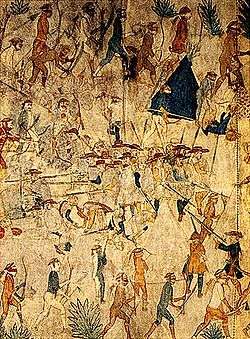Villasur expedition
| Villasur expedition | |||||||
|---|---|---|---|---|---|---|---|
| Part of the War of the Quadruple Alliance | |||||||
| |||||||
| Belligerents | |||||||
|
Pueblo Apache |
Pawnee Otoe | ||||||
| Commanders and leaders | |||||||
|
| |||||||
| Strength | |||||||
|
40 Spanish soldiers 60-70 Pueblo warriors 12 Apache warriors | |||||||
| Casualties and losses | |||||||
| 46 killed | |||||||
The Villasur expedition of 1720 was a Spanish military expedition intended to check the growing French influence on the Great Plains of central North America. Led by Lieutenant-General Pedro de Villasur, the expedition was attacked in present-day Nebraska by a Pawnee and Otoe force. Forty-six of the Spaniards and their Indian allies were killed. The survivors retreated to their base in New Mexico.
Background

In the first part of the 18th century, French explorers and fur traders began to enter the plains west of the Missouri River. In 1714, Étienne de Veniard, Sieur de Bourgmont became the first European known to have reached the mouth of the Platte River; other French traders may have visited the area and lived among the Indians.[3] Spain, which had claimed "ownership" of the Great Plains since the Coronado expedition of the 16th century, worried about the expansion of French influence in the region. In 1718, the War of the Quadruple Alliance broke out between France and Spain.[4]
Expedition
The governor of the Spanish colony of Nuevo México, based in Santa Fe, directed Villasur to capture French traders on the plains. Spanish authorities hoped to gather intelligence about French ambitions in the region. Villasur left Santa Fe on June 16, 1720, leading an expedition that included about 40 Cuera[lower-alpha 2] soldiers of a mounted frontier corps,[5] 60-70 Pueblo allies, a priest, a Spanish trader, and approximately 12 Apache guides. Jose Naranjo, scout leader and explorer, was of African-Hopi parentage. A war captain for the Spanish Indian auxiliaries, Naranjo had by 1714 already explored the Platte River region three times.[6]
The expedition made its way northeast through present-day Colorado, Kansas and Nebraska. In August, they made contact with the Pawnee and Otoe along the Platte and Loup rivers.[7] Using Francisco Sistaca, a Pawnee held as a slave (and renamed) by the Spanish, Villasur made several attempts to negotiate with Indians in the area. On August 13, Sistaca disappeared from camp. Nervous about the possibility of attack and the increasing number and belligerence of the Pawnee and Otoe, Villasur camped that night just south of the Loup/Platte confluence, near what is now Columbus, Nebraska.[lower-alpha 3]
Battle
At dawn on August 14, a large Pawnee and Oto force (possibly aided by French traders) attacked the sleeping Spanish camp. In a brief battle, they killed 36 Spaniards, including Villasur and Naranjo, 10 Pueblo scouts, [8] and Jean L'Archevêque, a Frenchman who was an interpreter for the Spanish.[9]The Pueblo allies had been encamped near, but separately from the Spanish and were not the first targets of the attack. The few "leather soldiers" who escaped were horse-holders, who were able to break loose while their comrades attempted to form a defensive cluster.
The Spanish and Pueblo survivors returned to Santa Fe on September 6. The expedition, which had journeyed farther to the north and east than any other Spanish military expedition, marked the end of Spanish influence on the central Great Plains.[10]
Notes
| Library resources about Villasur expedition |
- ↑ Three buffalo hide paintings depicting the battle were sent by the Jesuit missionary Philipp Segesser to his brother in Switzerland in 1758. They were identified and retrieved many years later.[2]
- ↑ So called from the protective leather clothing that Spanish frontier troops wore.
- ↑ The battle site was once claimed to have been near the confluence of the North Platte and South Platte rivers in western Nebraska.
References
- ↑ "Villasur Sent to Nebraska: Recording the Massacre", Nebraska Studies, accessed 24 August 2011. Note: The image features Naranjo, among others.
- ↑ Chávez, Thomas E. (1 January 1990). "The Segesser Hide Paintings: History, Discovery". Great Plains Quarterly. University of Nebraska - Lincoln: 96. Retrieved 2013-12-18.
- ↑ Norall, Frank (1988), Bourgmont, Explorer of the Missouri, 1698-1725, Lincoln: University of Nebraska Press, pp. 24-27
- ↑ "Villasur Sent to Nebraska: Recording the Massacre", Nebraska Studies, accessed 24 August 2011
- ↑ Chartrand, Rene (2011). The Spanish Army in North America. Osrey Publishing. p. 11. ISBN 978 1 84908 597 7.
- ↑ "Villasur Sent to Nebraska", Nebraska Studies, accessed 26 August 2011
- ↑ "Columbus or North Platte? Site of Spanish Massacre", Nebraska History and Record of Pioneer Days, 7 (3), 1924
- ↑ de Pastino, Blake (March 17, 2014). "First Evidence Found of Storied Battle That Stopped Spain's Eastward Expansion". Western Digs. Archived from the original on March 17, 2014. Retrieved March 23, 2014.
- ↑ Blake, Robert Bruce, Jean L'Archevêque, Handbook of Texas, retrieved 2008-02-07
- ↑ "The Villasur Expedition: The Battle", Nebraska Studies, accessed 24 August 2011
External links
- Nebraska Studies.org: "Villasur Sent to Nebraska"
- NMHistorymuseum.org: "The Segesser Hides Explorer" — virtual tour of the hides.